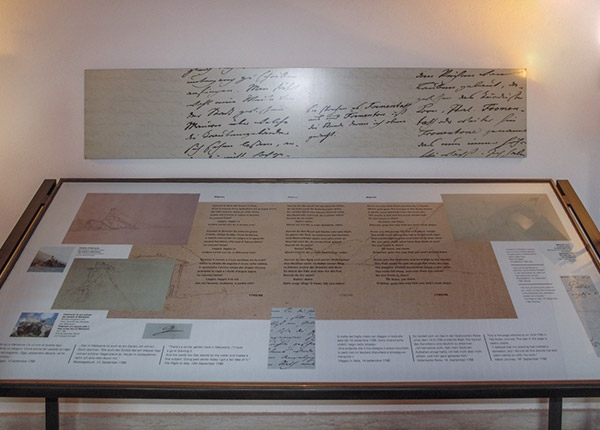Art and Culture in Malcesine
- HIGHLIGHT
- E_CITTA
- M_CULTURA_STORIA
- M_ARTE_CULTURA_TRADIZIONE
- METEO_NO_VENTO
- T_GENNAIO
- T_FEBBRAIO
- T_MARZO
- T_APRILE
- T_MAGGIO
- T_GIUGNO
- T_LUGLIO
- T_AGOSTO
- T_SETTEMBRE
- T_OTTOBRE
- T_NOVEMBRE
- T_DICEMBRE
Here you go, art by the lake, served with care. Your cultural visit among the beauty spots and history of Lake Garda, in the gentle interlude of Malcesine.
Art and culture in Malcesine represent one of the many ways to immerse oneself in history and understand the spirit of this area.
With a calendar full of happenings, cultural events in Malcesine have long enlivened the seasons.
Music concerts, performances, festivals, and art exhibitions turn this corner of paradise on Lake Garda into a place of entertainment and artistic cultural enrichment.
The natural splendour of Lake Garda is, in fact, not the only enticement.
For those in search of artistic and cultural treasures, the enchanting and old medieval village of Malcesine offers plenty of fascinating experiences to enjoy.
The most important cultural and artistic landmarks in Malcesine are Captains’ Palace and Scaliger Castle, containing valuable and historic works of art inside their elegant and majestic walls.
What Museums in Malcesine are worth seeing?
Malcesine is a town rich in history and culture, with many artistic places of interest to see. Art exhibitions can be found in various locations at Lake Garda.
Scaliger Castle is one of the main places of interest for holding art exhibitions in Malcesine.
The heart of the village, it fascinates us with its unquenchable beauty and the treasures it holds.
Inside, you will find countless works of great artistic value. It is a veritable museum of local history and the cultural heritage of Malcesine.
The most famous room is “Goethe Hall”, dedicated to the first artist who made our medieval village famous in Europe, thanks to the enchanting descriptions the famous writer published in 1816 in his work “Italian Journey”.
In the Hall, you can observe his original drawings of Scaliger Castle and the lake, which he sketched while staying in the village of Malcesine.

Scaliger Castle also houses the Natural History Museum of Mount Baldo and Lake Garda and temporary contemporary art exhibitions.
Although not a museum in the traditional sense, the Captains’ Palace in Malcesine, erected as a home for distinguished guests, it regularly hosts art exhibitions and conferences, and today has become a prominent cultural venue at Lake Garda.
In fact, in its charming and elegant Gothic and Venetian-style rooms, you can enjoy recitals, classical or opera music concerts, and see one-man exhibitions of painters and sculptors.
While you are there, you can also gain access to a vast repertoire of interesting volumes, including some in German and English. In fact, a municipal library has been opened in the renovated rooms of the Palace.
Here, you will get the chance to listen to good music as well, thanks to the various places for listening.
Afterwards, you can go to the delightful village of Cassone.
We recommend that you visit its authentic hidden gem, the Fishing Museum, just a few kilometres from Malcesine. Here, the local culture is revealed in all its authenticity. A unique artistic heritage.
The variety of art exhibitions in Malcesine allow you to discover new things, and give you the chance to admire works by local and international artists in incredible settings. Not to mention the chance to learn more about different artistic trends.
Finally, seize the chance to take part in folk festivals. During these cultural events in Malcesine, traditions come to life in an explosion of colours, flavours, sounds and artistic manifestations with a unique taste.
Which artists have been to Malcesine?
Among the many distinguished people who stayed in Malcesine, apart from Goethe, were Kafka, and the painter Gustav Klimt, who painted several paintings on canvas in 1913 with views of Malcesine and Cassone, later kept in the “Lederer” collection in Vienna and Graz.
Out of the numerous artists who lived in Malcesine and drew inspiration for their paintings, there were: Baroni, Luigi Belluzzi della Mainolda, Belgian Minders from Genk and the unforgettable Ottavio Giacomazzi of Malcesine, known and appreciated in many countries and particularly in Germany. His works, on display in major cultural centres of Europe, are the result of an intense artistic journey linked to his strong Garda roots.
We cannot fail to mention Enza Miglietta, an artist of contemporary art from Apulia, who, more than twenty years after her first day at Lake Garda, has chosen Malcesine as her home. She shares her art in our small village, where she managed to open her atelier.
When it comes to architecture in Malcesine, we suggest that you look at the churches. Artistic, historical, and cultural heritage of Lake Garda.
Deepen and explore the rich cultural experiences in Malcesine. They will delight you with a variety of flavours!